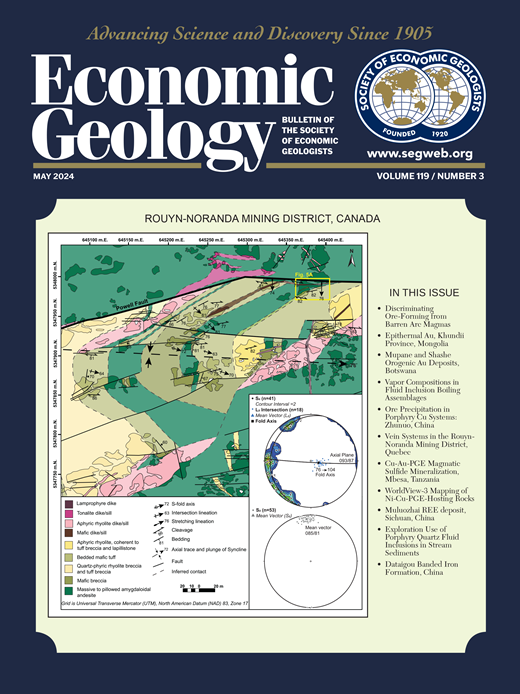IN SITU U-Pb MONAZITE GEOCHRONOLOGY RECORDS MULTIPLE EVENTS AT THE MOUNT ISA Cu (± Zn-Pb-Ag) DEPOSIT, NORTHERN AUSTRALIA
IF 5.5
1区 地球科学
Q1 GEOCHEMISTRY & GEOPHYSICS
引用次数: 0
Abstract
The Mount Isa Cu (± Zn-Pb-Ag) deposit is the largest Cu deposit in the Western fold belt of the Mount Isa inlier. Previous geochronological studies on the deposit have produced a large range (>150 m.y.) in ages for Cu mineralization and associated hydrothermal alteration. This study combines detailed petrology with in situ monazite U-Pb geochronology on four monazite-bearing samples in order to constrain the age of hydrothermal and tectonic events experienced by the Mount Isa Cu (± Zn-Pb-Ag) deposit and enclosing host shale. Samples EY108402 and EX102476 contain singular subangular monazite grains included in dolomite and siderite, which are associated with premineralization silica-dolomite alteration. Monazite from these samples yields mean weighted 207Pb/206Pb ages of 1587 ± 43 (mean square of weighted deviates [MSWD] = 0.57) and 1623 ± 25 Ma (MSWD = 0.61), respectively. These ages constrain the maximum age of silica-dolomite alteration and Cu mineralization, reflecting monazite growth during periods of peak metamorphism and early basin inversion, respectively. A sample from the 1100 Cu orebody (DDR012-2) contains two clusters of fine-grained monazite that replace siderite associated with silica-dolomite alteration, envelop chalcopyrite, and are crosscut by chlorite-quartz-orthoclase microveins. Monazite from these clusters produces 207Pb/206Pb ages ranging from ca. 1620 to ca. 1360 Ma. The large variation in ages is attributed to variable radiogenic Pb loss from a precursor monazite due to (1) continuous coupled dissolution-reprecipitation reactions over ca. 260 m.y. or (2) partial recrystallization by a ca. 1360 Ma fluid event. As monazite from this sample envelops chalcopyrite, the ca. 1360 Ma age can be used to infer the minimum age of Cu mineralization. Sample 1758-1 is from a highly silicified and fractured section of the Eastern Creek Volcanics located adjacent the deposit. The sampled fracture plane bears a chlorite-illite-rutile infill assemblage with fine-grained irregular-shaped monazite. Monazite from this sample produces a lower intercept age of 1376 ± 32 Ma (MSWD = 1.3) and is interpreted to represent the age of a major fluid flow event coeval with uplift along the Mount Isa fault. The monazite U-Pb geochronology presented in this study brackets the age of Cu mineralization and records the presence of multiple tectonic/hydrothermal events over the history of the deposit and enclosing host rocks.摘要原位U-Pb独居石年代学记录了澳大利亚北部ISA山铜(±Zn-Pb-Ag)矿床的多种地质事件
伊萨山铜(±Zn-Pb-Ag)矿床是伊萨山西褶皱带最大的铜矿床。前人对矿床的年代学研究得出了铜成矿和相关热液蚀变的大范围年龄(>150 m.y)。通过对4个单独居石样品的详细岩石学和原位单独居石U-Pb年代学研究,对伊萨山铜(±Zn-Pb-Ag)矿床及其包裹寄主页岩经历的热液和构造事件年龄进行了限定。样品EY108402和EX102476在白云岩和菱铁矿中含有奇异的亚角独居石颗粒,与矿化前硅-白云岩蚀变有关。这些样品中独居石的207Pb/206Pb平均加权年龄分别为1587±43 Ma(加权偏差均方根[MSWD] = 0.57)和1623±25 Ma (MSWD = 0.61)。这些年龄限制了硅白云岩蚀变和铜成矿的最大年龄,分别反映了变质峰期和盆地早期反转期的独居石生长。1100铜矿体(DDR012-2)样品含有两簇细粒独居石,它们取代了与硅白云岩蚀变有关的菱铁矿,包裹着黄铜矿,并被绿泥石-石英-正长石微脉横切。这些团簇中的独居石产生207Pb/206Pb,年龄约为1620 ~ 1360 Ma。年龄的巨大变化归因于前体独居石的放射性铅损失,这是由于(1)超过260毫安的连续耦合溶解-再沉淀反应或(2)1360毫安的流体事件造成的部分再结晶。由于该样品中的独居石包裹着黄铜矿,因此可以用1360 Ma的年龄来推断铜成矿的最小年龄。样品1758-1来自位于矿床附近的东克里克火山的高硅化断裂剖面。样品裂缝面为绿泥石-伊利石-金红石充填组合和细粒异形独居石。该样品中独居石的截距年龄较低,为1376±32 Ma (MSWD = 1.3),代表了Isa山断层隆升时期的一次主要流体流动事件的年龄。本研究提出的独居石U-Pb年代学记录了铜成矿时代,并记录了矿床和包裹寄主岩石历史上多次构造/热液事件的存在。
本文章由计算机程序翻译,如有差异,请以英文原文为准。
求助全文
约1分钟内获得全文
求助全文
来源期刊

Economic Geology
地学-地球化学与地球物理
CiteScore
10.00
自引率
6.90%
发文量
120
审稿时长
6 months
期刊介绍:
The journal, now published semi-quarterly, was first published in 1905 by the Economic Geology Publishing Company (PUBCO), a not-for-profit company established for the purpose of publishing a periodical devoted to economic geology. On the founding of SEG in 1920, a cooperative arrangement between PUBCO and SEG made the journal the official organ of the Society, and PUBCO agreed to carry the Society''s name on the front cover under the heading "Bulletin of the Society of Economic Geologists". PUBCO and SEG continued to operate as cooperating but separate entities until 2001, when the Board of Directors of PUBCO and the Council of SEG, by unanimous consent, approved a formal agreement of merger. The former activities of the PUBCO Board of Directors are now carried out by a Publications Board, a new self-governing unit within SEG.
 求助内容:
求助内容: 应助结果提醒方式:
应助结果提醒方式:


